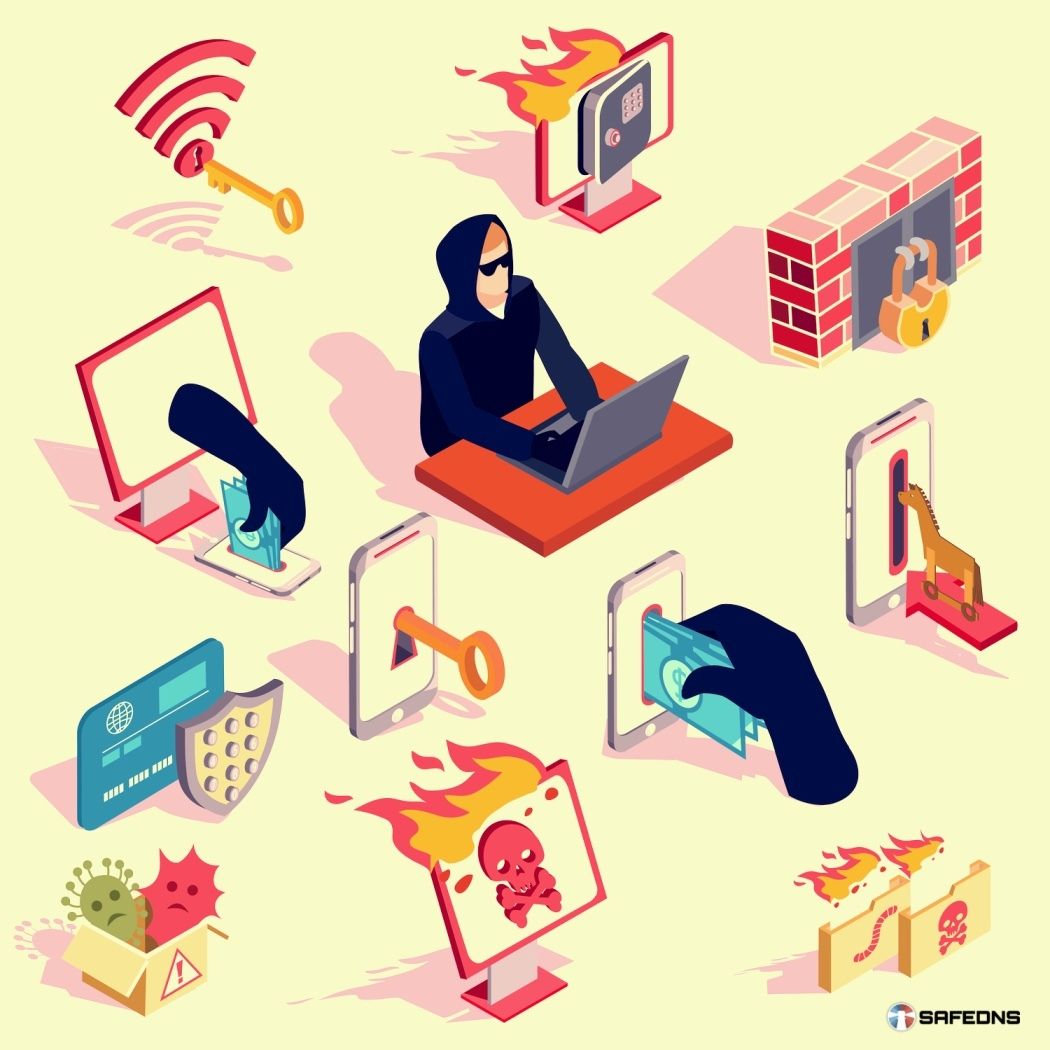
Types of Malware and Their Impact on Your Computer: A Comprehensive Guide
Have you ever experienced the frustration of a slow and unresponsive computer, only to discover later that it fell victim to malware attacks? Malicious software, or malware, is a prevalent online threat that cybercriminals use to orchestrate various nefarious actions. This article aims to shed light on the different types of malware, how they operate, and, most importantly, how you can protect your devices from these insidious attacks.
Understanding Malware: A Menace in the Digital World
Malware serves as an umbrella term encompassing various online threats that devices frequently encounter. The diverse range includes computer viruses, spyware, worms, adware, ransomware, botnets, Trojan horses, and other malicious programs. The dynamic nature of these threats means that a piece of malware on your computer can morph from one type to another as hackers adapt to exploit vulnerabilities in your device.
Computer Viruses
Computer viruses attach themselves to legitimate programs or files, duplicating to compromise your computer and launch an attack. Infamous examples, such as the "ILOVEYOU" virus in 2000, spread through millions of emails, demonstrating the potential financial and operational havoc caused by such attacks.
Spyware
Spyware operates covertly, infiltrating systems without authorization to steal data or create a backdoor for additional payloads. This form of malware is akin to scenarios depicted in popular media, where characters engage in espionage to compromise vital systems.
Worms
Contrary to the harmless invertebrates in your garden, computer worms are designed to infect other computers, often multiplying based on conditions met by other malware they contain. Their goal is to disrupt the functions of your computer's software and hardware.
Adware
Adware tracks user online activities, such as browsing and downloading, to display persistent and challenging-to-close advertisements. This type of malware often serves as an entry point for subsequent attacks, sometimes originating from seemingly harmless free software.
Botnets
Botnets leverage multiple compromised computers to launch attacks, occasionally resulting in Distributed Denial of Service Attacks (DDoS). Notable instances, like the Mirai botnet, highlight the potential impact of coordinated attacks orchestrated by cyber criminals.
Cryptocurrency Miner or Cryptojacking
This attack exploits the computing power of an infected machine to mine cryptocurrencies like Litecoin, Ethereum, Bitcoin, or Ripple. Victims are often unaware that their resources are being used for cryptocurrency mining.
Keylogger or Keystroke Logging
Keyloggers discreetly record users' keyboard activities, tracking emails or browsing activities to spy on or steal login credentials. These attacks can occur when users open emails from compromised networks or leave their devices unattended.
Rootkits
Rootkits provide remote unauthorized access to a cybercriminal, often eluding detection by antivirus software. Removing rootkits can be challenging, occasionally requiring the reinstallation of the operating system or specialized tools.
Ransomware
Familiar to those who watched Black Mirror's 'Shut Up and Dance' episode, ransomware encrypts data and demands payment for its release. Victims are coerced into paying a ransom under the threat of escalating consequences.
Trojan Horses
Trojan horses cause subtle changes in computer settings and can go unnoticed. They may remain dormant until triggered, as seen in the 2009 Zeus attack that stole login credentials from prominent organizations.
Sophisticated Malware Attacks and Evolving Threats
As technology advances, so do malware attacks. Cybercriminals continually develop more sophisticated methods to gain unauthorized access to systems, exploiting vulnerabilities in software and devices. It's essential to be aware of these evolving threats to fortify your digital defenses.
Fileless Malware
Fileless malware operates without leaving traditional traces on the file system, making it challenging to detect. It often resides in a computer's memory, executing malicious code without a physical presence on the device. This advanced technique poses a significant threat to conventional security measures.
Mobile Malware
With the widespread use of mobile devices, cybercriminals have shifted their focus to target smartphones and tablets. Mobile malware encompasses malicious code designed to compromise the security of mobile devices, leading to unauthorized access or data theft.
Ransomware Attacks
Ransomware attacks have become increasingly prevalent, targeting individuals, businesses, and even governmental organizations. These attacks encrypt valuable data, rendering it inaccessible until a ransom is paid. Staying vigilant and implementing robust security measures is crucial to thwarting ransomware threats.
Malicious Links and Code
Malicious links embedded in emails or websites serve as gateways for malware. Clicking on these links can initiate the download of malicious code, leading to infections. Understanding the risks associated with such links is paramount to preventing malware infiltration.
Software Vulnerabilities
Cybercriminals often exploit vulnerabilities in software to deliver malware. Regularly updating operating systems, applications, and software patches these vulnerabilities, reducing the risk of falling victim to sophisticated attacks.
Safeguarding Against Malware: Strategies for Protection
Now that we've explored the various forms of malware, including fileless malware, mobile malware, and the evolving landscape of sophisticated attacks, it's crucial to understand how to protect your devices from these insidious threats. Here are practical strategies to fortify your defenses:
Education and Training
Whether you're a business owner, solo entrepreneur, or an individual, investing in cybersecurity courses or providing training to employees can enhance awareness and preparedness against potential threats.
Antivirus Software
Regularly update or install antivirus software on every computer you own. This acts as a crucial line of defense against known malware strains and provides real-time protection.
Web Filtering
Vigilance in Email Communications
Exercise caution when receiving emails, especially from unknown or unauthenticated sources. Avoid clicking on links or downloading attachments that may contain malware.
Unified Threat Management (UTM) Firewall
Implement a UTM firewall that combines web filtering, anti-spam, anti-virus, and content filtering. This comprehensive approach enhances protection against a range of malware.
Password Hygiene
Regularly change passwords and avoid using easily guessable or common phrases. Consider employing a password generator to enhance security, and never use passwords like "covfefe" or "hakuna matata."
Software and System Updates
Promptly update operating systems, applications, and software when updates are available. Regular updates patch vulnerabilities and strengthen your defense against evolving malware threats.
Multi-Factor Authentication (MFA)
Implement MFA, combining multiple security methods, to add an extra layer of protection. This approach significantly reduces the risk of unauthorized access.
User Account Management
Enforce individual user accounts for staff, limiting access to sensitive information and minimizing the potential impact of malware.
Physical Access Control
Monitor and control physical access to computers and network components, preventing unauthorized individuals from compromising your devices.
Secure Wi-Fi Networks
If using a Wi-Fi network, ensure it is secure and hidden to minimize the risk of unauthorized access and potential malware infiltration.
Regular Data Backups
Backup critical business information and sensitive data regularly. In the event of a malware attack, having recent backups can expedite recovery without succumbing to ransomware demands.
Access Control Levels
Establish varying levels of access for installing software or managing databases/applications with sensitive information. Restricting access minimizes the potential impact of malware.
Conclusion: Safeguarding Your Digital Domain
Navigating the ever-evolving landscape of malware threats requires a proactive and informed approach. If the intricacies of malware protection feel overwhelming, seeking advice from cybersecurity consultants or specialized vendors can provide tailored solutions.
Protecting your network or computer is an ongoing commitment. By staying abreast of relevant security practices, continuously updating security measures, and fostering a culture of cybersecurity awareness, you fortify your digital defenses against the relentless tide of malware threats. Stay vigilant, stay informed, and safeguard your digital domain against the unseen adversaries lurking in the online realm.
Start using SafeDNS for free
Take advantage of the SafeDNS trial period and try all the best features
Take advantage of the SafeDNS trial period and try all the best features

